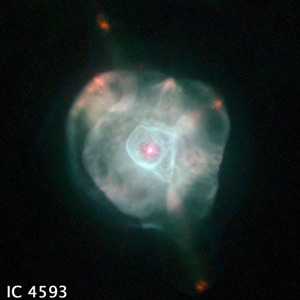Every now and again I’ll see an image of an astronomical object and think, what the heck?
CRL 618 is definitely one such object!
This Hubble image threw me for a sec: it looks like a planetary nebula, but where’s the central star? What are those long fingers of matter? So I started going through the scientific literature and found some good explanations. And I learned something!
CRL 618 is a star announcing it’s on its way to becoming a planetary nebula. When stars like the Sun die, they expand hugely and cool off, becoming red giants. They then emit a solar wind that is slow (in astronomical terms at least) and dense. After a few thousand years, as the star loses more and more mass from its outer layers, the deeper, hotter part is exposed. The wind emitted speeds up, slams into the slower wind, compressing it, and ultraviolet from the exposed stellar core lights it up. The result is a beautiful planetary nebula, like the famous Helix Nebula.
 That’s all well and good, but this model of interacting winds has a problem explaining some of the features commonly seen in planetary nebulae (or PNe for short). In this picture of IC4593, for example, there are knots and long linear features. How did those get there?
CRL 618 is, perhaps, telling us how! Here’s the (probable) scoop: deep in its heart lies not one star, but two. One of them is a red giant, and the other is probably a lower mass star, and they orbit each other as a close binary system. Because they’re rapidly spinning around each other, a lot of the dust and junk blown off by the red giant heads off in the plane of the stars’ orbits. That’s why the center of the nebula is dark! The stars are there, just hidden beneath all that junk.
That’s all well and good, but this model of interacting winds has a problem explaining some of the features commonly seen in planetary nebulae (or PNe for short). In this picture of IC4593, for example, there are knots and long linear features. How did those get there?
CRL 618 is, perhaps, telling us how! Here’s the (probable) scoop: deep in its heart lies not one star, but two. One of them is a red giant, and the other is probably a lower mass star, and they orbit each other as a close binary system. Because they’re rapidly spinning around each other, a lot of the dust and junk blown off by the red giant heads off in the plane of the stars’ orbits. That’s why the center of the nebula is dark! The stars are there, just hidden beneath all that junk.
Also, a lot of that material forms a smaller disk, called an accretion disk, just around the second star. This (and magnetic fields probably play a role too) helps focus material along the poles of the system, blowing it up and out – there’s less matter up that way, so its easier for material to flow up and down. That’s what causes those long fingers of material seen in the Hubble image of CRL 618. There are probably episodic pulses of energy that fling out matter, which is why there’s more than one finger. And in between those episodes the poles of the system have moved, like a top wobbles as it spins (called precession).
Most likely these fingers will continue to grow, and as they hit the previous emitted gas they’ll form those knots and other weird features seen in PNe like IC4593. The details of all this are fiercesome to determine, of course. For example, each individual finger has waves inside, as if there were more than one pulse blasting out matter to form each finger, and each pulse piles up more material in front of it like a snow plow. Why does that happen? How does matter get accelerated to such velocities (hundreds of kilometers per second!)? How does this process start, and how does it shut down?
Because shut down it does. This stage in a star’s life may only last a few hundred years – as little as only 0.000001% of a star’s entire life. That means we don’t get very long to look, and it’s so brief that we only see a few dozen proto-planetary nebulae like this.
However, keep in mind the scale here. These features may be young and small compared to the entire nebula, but they’re still hundreds of billions of kilometers long!
I find planetary nebulae endlessly fascinating. They are so ethereally beautiful, so complicated, so intricate… and they’re showing us in some ways what the Sun might look like in six billion years (give or take). And while it’s possible the Sun won’t have enough oomph to be able to light up its gas the way most planetary nebulae do, the forces at work are literally universal, and what we learn observing these gorgeous dying stars informs us on how our own star will age and eventually die.
Image credit: ESA/Hubble & NASA
Related posts:
- Warm, dusty rings glow around a weird binary star
- A delicately violent celestial shell game
- Down the throat of a dying star
- Night FLIERs